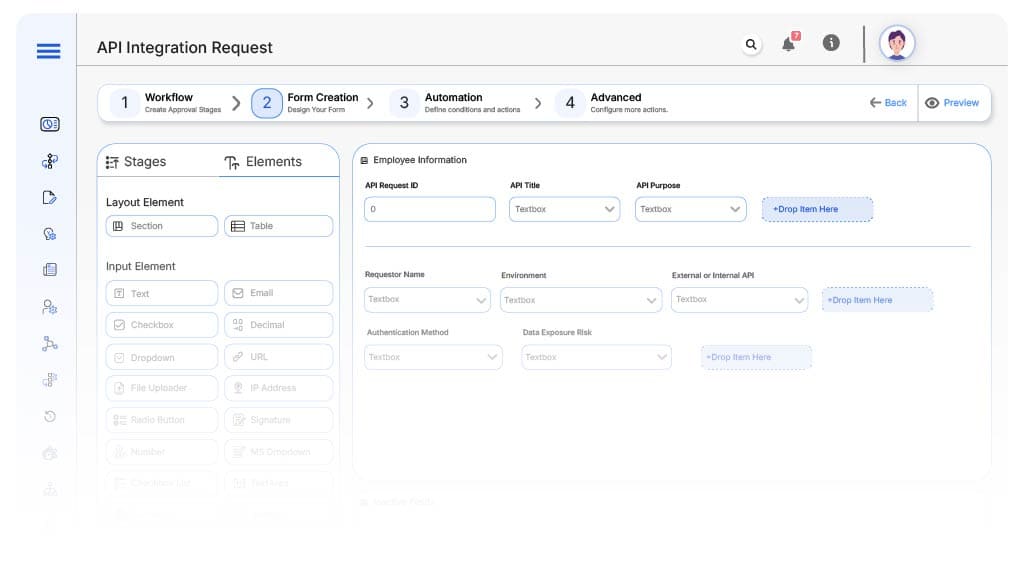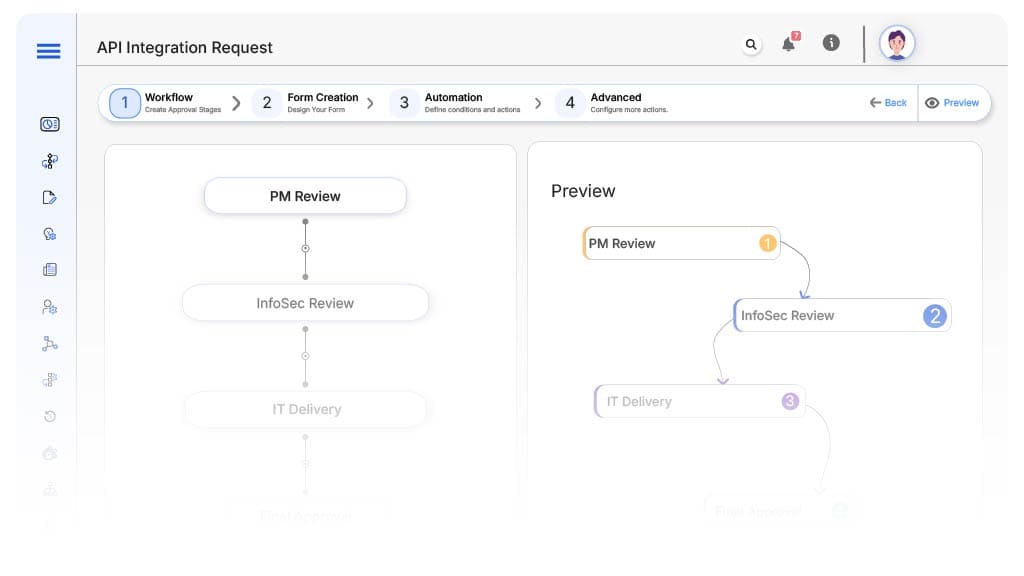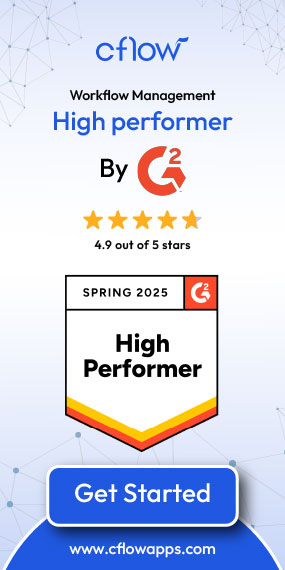- Cflow
- API Integration Request Automation
API Integration Request Automation

Clow Team

The API Integration Request Process is critical for ensuring secure, compliant, and efficient connections between internal systems and third-party platforms. When managed manually, integration requests often result in delays, incomplete documentation, missed security checks, and audit gaps.
In today’s hybrid IT environments, where teams frequently consume external APIs and expose internal endpoints, a structured and automated approach becomes essential. Without workflow control, integration efforts get bottlenecked between business users, IT, and InfoSec, leading to inconsistent credential handling and missed timelines.
This guide walks through how Cflow automates the API Integration Request Process from initial submission to final implementation, with proper reviews, dependencies, and full audit tracking.
What Is API Integration Request Process?
The API Integration Request Process is the structured workflow used by organizations to evaluate, approve, and implement API connections, whether internal or external. It helps streamline submission, validate security and compliance, assign roles, and control environments.
Think of it like a secure airlock system: every API request must go through validation checks, approvals, and documentation gates before it’s allowed to “dock” with your internal systems.
According to DevOps research, 40% of API failures in enterprises stem from poor coordination between developers, security, and IT. Automating the API intake and approval lifecycle is essential to avoid breaches, misconfigurations, and delays.
Why API Integration Request Process Is Important for IT Teams
Standardization
Security Compliance
Auditability
Faster Delivery
Key Benefits of Automating API Integration Request Process with Cflow
- Centralized API Request Portal: Cflow offers a unified portal where business users and developers submit API needs. All required fields from endpoint specs to authentication method are captured in structured form, reducing back-and-forth and eliminating ambiguity. Teams track request status in real time and avoid lost emails or Slack threads. The portal creates transparency, standardizes intake, and aligns all stakeholders early in the process.
- Security & Compliance Gate Checks: Each request automatically routes to Information Security and Compliance for validation. Required fields like data exposure, encryption standards, token handling, and rate limits are mandated. Cflow blocks progression unless all security controls are fulfilled. This ensures integrations do not bypass security reviews and dramatically reduces risk from insecure API connections.
- Version & Environment Control: Cflow requires requesters to specify the environments (dev, test, prod) and API versions during submission. This prevents credential misrouting, version mismatches, or untracked deployments. Environment-based logic ensures requests are routed to the correct DevOps team and that approval timelines align with staging schedules.
- Multi-Level Approval Routing: Requests first go to the Project Manager or Product Owner, then to InfoSec, and finally to IT Delivery. Cflow enforces dependency-based routing—no task proceeds until prior approvals are completed. This ensures clarity, accountability, and compliance. Teams know exactly where a request stands and what’s pending.
- Real-Time Escalations & Reminders: Cflow alerts users and managers when approvals or tasks are delayed. IT and security leads receive weekly dashboards showing pending items. Automated reminders and escalations help avoid bottlenecks and keep integration timelines on track. No more manual follow-ups or missed Slack threads.
- Repository Linkage & Documentation: Submitters attach API specs, Postman collections, or GitHub links directly within the Cflow form. All documentation stays linked to the request and is version-stamped. Auditors or team members can trace every decision and document associated with the integration, improving transparency, onboarding, and support.
- Mobile Workflow Access: Cflow’s mobile interface allows stakeholders to initiate, approve, or track requests on the go. Developers, product managers, and IT leads working across time zones or in the field can act without delays. Mobile access ensures integrations stay on schedule regardless of location.
Get the best value for money with Cflow
User Roles & Permissions
Requestor (Developer or Team Lead)
- Responsibilities: Initiate API integration request, provide technical details, and attach documentation.
- Cflow Permission Level: Submit Form.
- Mapping: “Integration Requestors” group.
API Owner (Internal Product or Data Team)
- Responsibilities: Review API use case, validate alignment with internal guidelines, approve or reject requests.
- Cflow Permission Level: Approve/Reject.
- Mapping: “API Owners” group.
Security Officer
- Responsibilities: Perform risk assessment, validate encryption, data handling, and access controls.
- Cflow Permission Level: Task Owner.
- Mapping: “Security Review Team” group.
Compliance Reviewer
- Responsibilities: Check compliance with internal policies, regulatory requirements, and data privacy laws.
- Cflow Permission Level: Task Owner.
- Mapping: “Compliance Team” group.
Integration Architect
- Responsibilities: Validate system compatibility, assess architecture impact, and assign integration resources.
- Cflow Permission Level: Approve/Reject.
- Mapping: “Integration Architects” group.
IT Admin
- Responsibilities: Provision credentials, configure environments, whitelist API endpoints.
- Cflow Permission Level: Task Owner.
- Mapping: “IT Operations” group.
Audit Officer
- Responsibilities: View complete approval trail for audit readiness and security logs.
- Cflow Permission Level: View Only.
- Mapping: “Audit Team” group.
Discover why teams choose Cflow
Form Design & Field Definitions

Field Label: API Request ID
- Type: Autonumber
- Auto-Populate: Generated on submission.
Field Label: API Title
- Type: Text
- Logic/Rules: Required
Field Label: API Purpose
- Type: Text Area
- Logic/Rules: Required
Field Label: Requestor Name
- Type: Text (Read-only)
- Auto-Populate: User submitting form
Field Label: Environment
- Type: Dropdown (Dev, Test, Prod)
- Logic/Rules: Controls routing logic
Field Label: External or Internal API
- Type: Radio Button
- Logic/Rules: Impacts security check requirements
Field Label: Authentication Method
- Type: Dropdown (API Key, OAuth2, JWT, None)
- Logic/Rules: Security section must validate
Field Label: Data Exposure Risk
- Type: Dropdown (Low, Medium, High)
- Logic/Rules: Mandatory for InfoSec review
Field Label: Linked Documentation
- Type: File Upload or URL
- Logic/Rules: Required for request submission
Field Label: PM Approval
- Type: Checkbox
- Logic/Rules: Required to proceed to Security
Field Label: InfoSec Approval
- Type: Checkbox
- Logic/Rules: Required to proceed to IT
Field Label: InfoSec Approval
- Type: Checkbox
- Logic/Rules: Required before closure
Transform your Workflow with AI fusion
Approval Flow & Routing Logic

Submission → PM Review
- Status Name: Pending PM Approval
- Notification Template: “New API request submitted: {API Title}. Please review and assign priority.”
- On Approve: Routes to InfoSec Reviewer
PM → InfoSec Review
- Status Name: Pending InfoSec Approval
- Notification Template: “Security review needed for {API Title}. Validate encryption, auth, and data exposure.”
- Escalation: Reminder after 2 days
- On Approve: Routes to IT Delivery
InfoSec → IT Delivery
- Status Name: Pending IT Delivery
- Notification Template: “Validate environment, credentials, and deployment for {API Title}.”
- Escalation: Reminder after 2 days
- On Approve: Routes to Completion
Final → API Integration Completed
- Status Name: Integration Complete
- Notification Template: “API request for {API Title} is approved and delivered. Documentation archived.”
Transform your AI-powered approvals
Implementation Steps in Cflow
Create a new workflow
Design the form
Set up User Roles/Groups
Build the process flow diagram
Configure notifications
Apply routing rules
Save and publish workflow
Test with a sample request
Fine-tune
Deploy
Example Journey: API Request from Sales App
FAQ's
Unleash the full potential of your AI-powered Workflow

